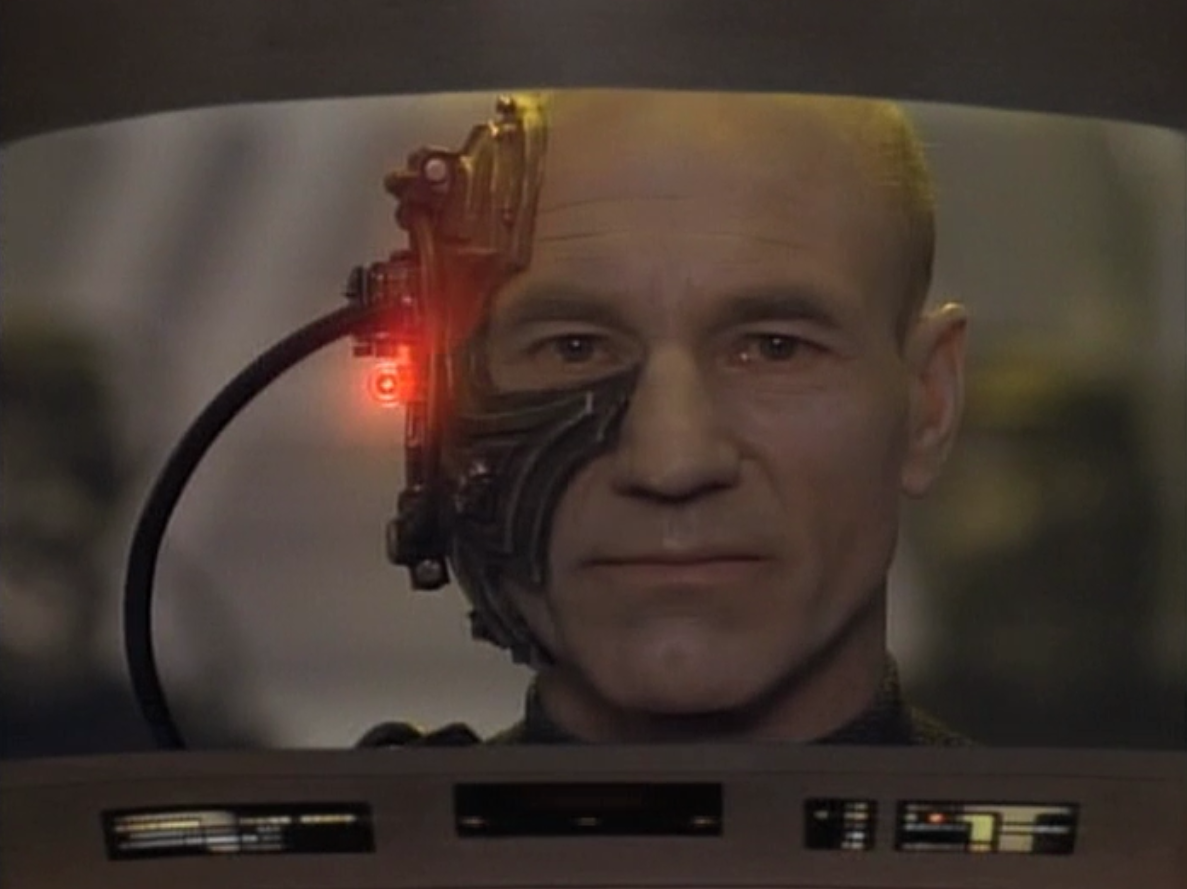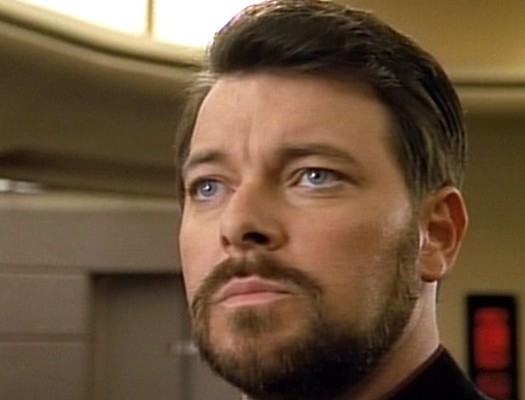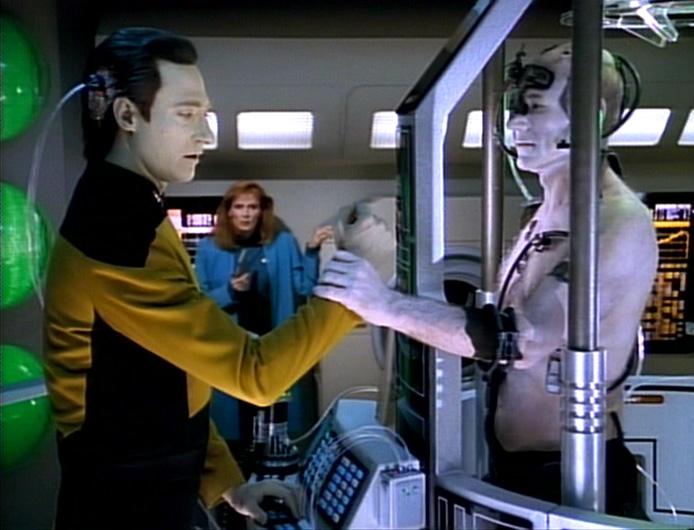
Part I: The Enterprise discovers that the Borg (see “Q Who?”) have made it to Federation space. After a brief encounter with a cube in which the Borg say they want Picard, the Enterprise hides in a nebula while the crew begins to build a weapon that they believe will destroy the Borg ship (based on what they learned in the earlier encounter). The Borg force the Enterprise out of the nebula, kidnap Picard and set course for Earth. Riker sends an away team to the Borg ship, which finds Picard, assimilated — in one of the franchise’s signature moments. The away team manages to get the Borg ship out of warp — and Riker, facing an assimilated Picard, now Borg spokesman Locutus, on the view screen — tells Worf to fire the new weapon. Then, a million nerds threw their remotes at the TV and wondered how they’d get through the summer.
Part II: The Borg, armed with Picard’s knowledge, are unaffected by the attack. The failed attempt has left the Enterprise damaged and the Borg head on their merry way to Earth. Riker, promoted to captain via subspace, seems lost at first without Picard. But encountering 39 Starfleet vessels destroyed at Wolf 359 provides him with resolve. He kidnaps Picard and uses Data to tap into the information about the Borg within him. With the Borg vessel orbiting Earth, Picard manages to reach out to Data and suggests putting the Borg to sleep — which causes a malfunction that destroys the ship. Picard is saved, but clearly messed up, as the episode ends.

Why it’s important
Simply put, this is TNG’s most consequential showing — and it should have really been more consequential than it was. But, first the good.
It’s not overkill to say that the events here (and, really, the actions by Riker) saved the known galaxy. At one point Troi says that in a few weeks “nanites might be all that’s left of the Federation.” The stakes here are as high as they get in TNG and are actually higher than in two of the TNG movies. If the Enterprise hadn’t been successful, Star Trek pretty much ends. For more, check out the alternate-reality episode “Parallels” in TNG’s seventh season, when we get a glimpse at the Enterprise (“one of the last ships left!”) three years after the Borg have (presumably) assimilated Earth.
Picard’s assimilation is a major bit of back story for the character and the franchise. We see fallout in TNG’s next episode (“Family”), in other shows through the years (“The Drumhead”, “I, Borg”, the “Descent” two-parter and the previously mentioned “Parallels”). Of course, you could argue that Picard’s knowledge of the Borg (post-assimilation) helped him lead the final attack in “Star Trek: First Contact” that ultimately destroyed another Borg cube threatening Earth.
The battle at Wolf 359 is also a major bit of back story for Benjamin Sisko. The death of his wife at that battle (on board the Saratoga) essentially puts him on a trajectory to be the commander of DS9 two-plus years later as a damaged man unable to get over the past.

What doesn’t hold up
If you can get past the Borg wanting Picard as their spokesman — with the thinking being that archaic cultures are “authority driven” — the first part of this episode is just about perfect. It’s kind of annoying that Starfleet’s Borg expert, Lt. Commander Shelby (Elizabeth Dennehy) is worried about her career (that Riker is blocking it) as a major invasion looms, but I can get past that. Part II is more problematic …
The episode’s big conceit is that the Borg ship doesn’t simply destroy or assimilate the Enterprise after the deflector beam thing fails. I’m sure it could be argued that the Borg no longer saw the Enterprise as a threat, but that’s a stretch. Clearly, it would have been easy and smart to simply destroy the most powerful ship in the Federation fleet.
Most of the show’s final 15 minutes are somewhat questionable. For one thing — as we noted previously — why wasn’t someone from Earth, Starfleet or the Federation generally in contact with the Enterprise after the ship goes through the Wolf 359 wreckage? A lot of Starfleet was wiped out, but much of it remained (based on what we see later). If nothing else, shouldn’t the Federation president have been trying to get Riker on the horn? There’s no indication the Borg were blocking transmissions (which would have been an easy line of dialog to throw in, BTW). Beyond that, wouldn’t Starfleet have left a couple ships to defend Earth — beyond the rather paltry Mars defense perimeter vessels? Or, maybe, some ships that weren’t able to reach Wolf 359 would have been en route to Earth, possibly attempting to contact the Enterprise? I know that might have cluttered things up, but still …
Then, there’s the idea that planting a bad command within the Borg ship would cause it to self-destruct. The execution is good, but I’ve never bought the premise. Wouldn’t it have made much more sense for the command to be entered, for the Borg to lower their defenses and for the Enterprise to have just blown it to hell after that? I know that’s not exactly in keeping with Roddenberry’s usual vision, but it seems like an exception could be made when the fate of Earth and the Federation is at stake!
Also, it’s pretty clear that, at the time this episode was released, the loss of 39 starships was seen as a big hit to Starfleet. Shelby, at the end of the episode, actually says that a task force will have the fleet up and running within a year. This is somewhat buoyed by Picard’s struggles to get a fleet together a year later in the “Redemption” two-parter and other dialog in the fourth season alluding to Starfleet being sort of strapped. Essentially, in TNG and even early DS9, Starfleet is big — but not enormous.
But, in mid- to late-DS9, Starfleet is shown to have hundreds, maybe thousands of vessels. There never was talk of a build-up of ships — though one certainly would have been possible with all the threats facing the Federation in the late 2360s and early 2370s. Maybe, with a conflict with the Dominion looming and the threat of more Borg attacks, Starfleet called in its vessels that had been in deep space, exploring? Again, it’s possible, but never stated.
Lastly, it’s odd the level to which things return to normal after this episode. Other than one attaboy for Riker (in “The Wounded”) and the ship issues in“Redemption”, TNG doesn’t feel like the Federation was almost wiped out. This is something DS9 and Enterprise did much better (though Voyager did much, much worse). I’ll give the creators props for “Family” — the following episode, in which Picard struggles with the emotional toil of what’s happened. It’s also smart that several weeks (maybe even a couple months) pass between the end of Part II and the regular episode after “Family”. But, in that episode (“Suddenly Human”) things are really back to status quo. Shame.
Final thoughts
Complaints aside, this was TNG’s peak. Aside from a few classic episodes in the following years, notably “The Inner Light”, never again did TNG work as well — though it was still very good and didn’t fall far until some truly awful episodes in season 7.
Oh, this marks the first time where the creators’ decision to have second-generation Trek seasons coincide with calendar years (unlike TOS) produce unintended comedy. With the cliffhanger here — and the many that followed at the end of seasons on TNG, DS9 and Voyager — calendar years often ended with really bad things happening to our heroes! From a practical perspective, the success of “The Best of Both Worlds” likely inspired other cliffhangers. But it sure must have wrecked a lot of New Year’s Eve plans on the Enterprise, DS9 and Voyager. 🙂
Coming next week …
Worf’s a daddy! No, really.
